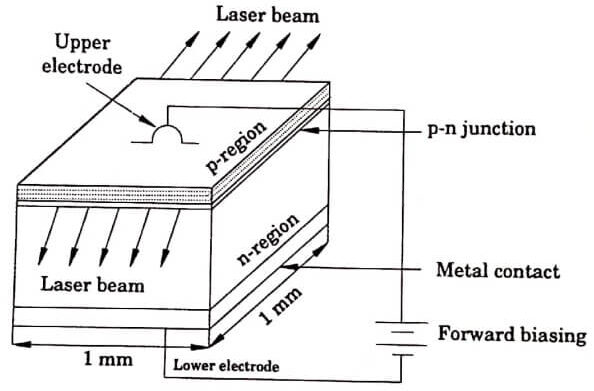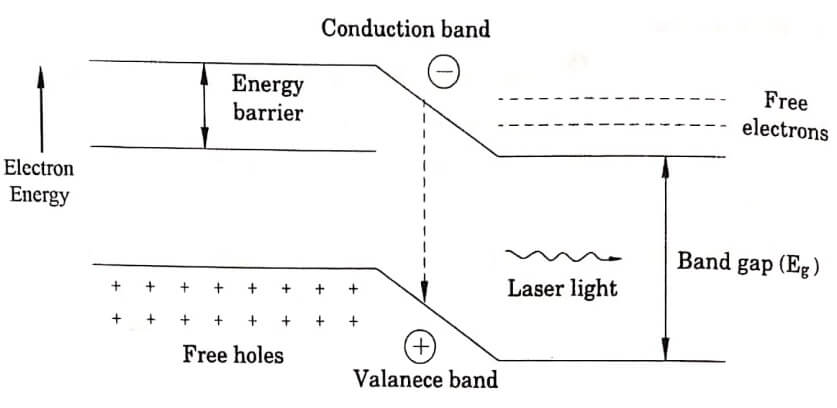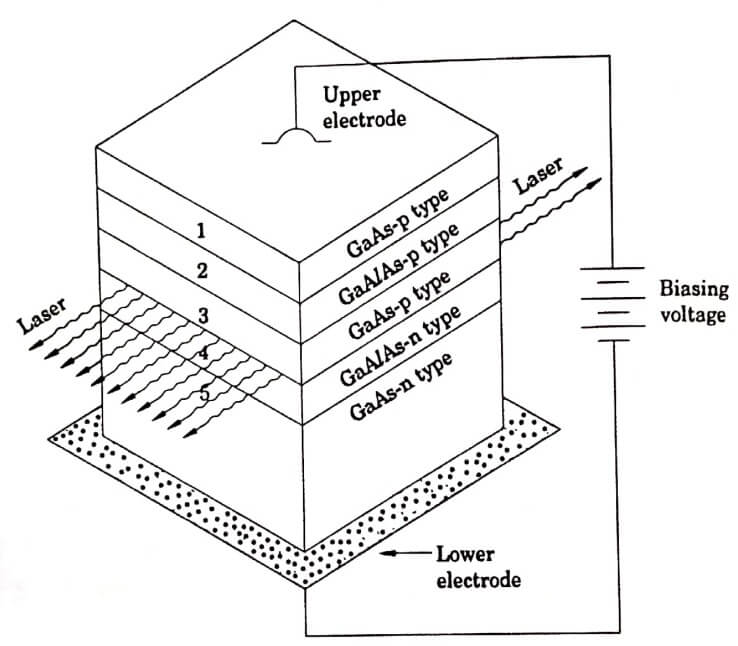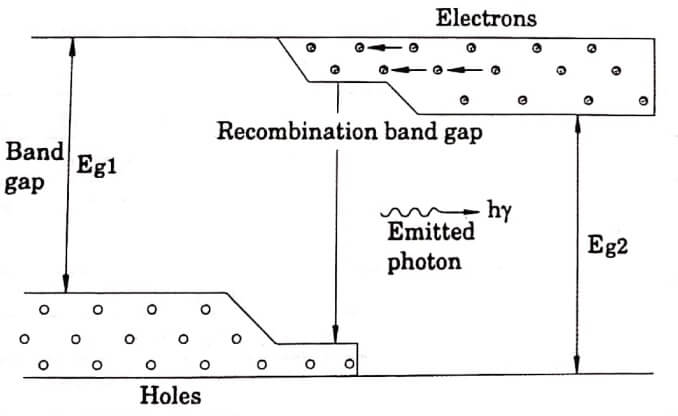Laser action can also be produced in semiconductors. The most compact of all lasers is the semiconductor laser. It is also called injection laser. A semiconductor laser is a specially fabricated p-n junction device that emits coherent light when forward – biased.
Types of semiconductor laser
There are two types of semiconductor lasers:
(i) Homojunction laser
Homojunction means that a p−n junction is formed by a single crystalline material.
E.g., : Gallium arsenide (Ga-As).
(ii) Heterojunction laser
Heterojunction means that the junction has one material on one side and a different material on the other side. It is also called modern laser.
E.g., : Gallium aluminium arsenide (Ga-Al-As).
Homojunction laser
The most compact of all lasers is the semiconductor laser. It is produced by stimulated emission by recombination of holes and electrons. These holes and electrons are produced in the depletion region by the direct flow of current. The population inversion in the depletion region is responsible for laser action. This kind of laser is called as homojunction semiconductor laser or injection laser or p−n junction laser.
Characteristics
| Type | Homojunction semiconductor laser. |
| Active medium | P-N junction diode. |
| Active centre | Recombination of electrons and holes. |
| Pumping method | Direct pumping ( electrical energy to optical energy) |
| Optical resonator | Junction of diodes – polished. |
| Power output | 1mW |
| Nature of Output | Pulsed (or) continuous wave form. |
| Wavelength of the output | 8400 Å – 8800 Å |
| Band gap | 1.44 eV |
Principle
When a forward bias is applied to the heavily doped p-n junction diode the electrons are injected into the p – side of the junction and holes are injected into the n-side. The recombination of holes and electrons with in the junction region results in recombination radiation. This region is called depletion region.
If the concentration of recombination ions is more than the concentration of majority carrier in the p-type or n-type, then it is called ‘population inversion’. During recombination process, light radiation (photons) is released from direct band gap semiconductors like gallium arsenide. It stimulate other charges and as a result, stimulated emission takes place which leads to laser light.
Construction
The active medium is a p-n junction diode made of crystalline Gallium arsenide. This p-region is doped with Ge and n-region is doped with Tellurim. The p-n junction layer is very thin like a few microns.
Electric current is applied to the p-n junction diode through strip electrode. The end faces of the junction diode are well polished and parallel, so that they act as an optical resonator.

Working
- In a p-n junction diode the p-type and n-type regions are heavily doped.
- Under large applied forward bias, electrons and holes are injected into the junction and as a result, the region around the junction contains large number of electrons within conduction band and large number of holes with in the valence band.
- When the population density is high enough, a condition of population inversion is achieved and recombination may be stimulated resulting in laser action as shown in the energy level diagram. (Fig.1.2). Hence the wavelength of light emitted is 8400Å.

Advantages
-
Efficiency is high.
-
It is highly economical.
-
It is small and compact.
-
It can have a continuous wave output (or) pulsed output.
-
The modulation of the output is possible.
Disadvantages
-
Laser output has large beam divergence.
-
Coherence of laser beam is very poor.
-
Threshold current density is very large.
Applications
- It is mostly used in fibre optic communication.
- It is used in printers for computer printouts, writing and reading CD’s.
- It can be used as a pain killer.
- It is used to produce laser diodes which are more powerful and coherent than LED.
Heterojunction laser
A p-n junction made up of different material with two regions, n-type and p-type is known as heterojunction. Two types of heterojunction are available.
- Isotype heterojunction (made up of two different materials having same type of conductivity).
- Anisotype heterojunction (made up of two different materials having different conductivity).
Characteristics
| Type | It is a Heterojunction semiconductor laser. |
| Active medium | p-n junction made from different layers. |
| Pumping method | Direct conversion method. |
| Power output | The power output of laser beam is 10mW |
| Nature of Output | Continuous wave form. |
| Wavelength of the output | Nearly 8000Å |
| Band gap | 1.55 eV |
Principle
When p-n junction diode is forward biased, electrons from n region and holes from p-region recombine with each other at the junction. During recombination process light is released from certain. specified direct band gap semiconductors.
Construction
Heterojunction semiconductor laser consists of five layers as shown in (Fig.1.3).

Fig. 1.3 Heterojunction semiconductor laser
A layer of Ga-As- p-type ( 3rd layer) will act as the active region. This layer is sandwitched between the two layers having wider band gap, GaAlAs – p-type (2nd layer) and GaAlAs n-type (4th layer). Electric current is applied to the crystal through the electrode which is fixed on the top and bottom layers. The end faces of the junctions of 3rd and 4th layer are well polished and parallel to each other. They act as the optical resonator.
Working
- The energy level diagram is shown in (Fig.1.4). When the p−n junction is forward biased, the electrons and holes are injected into the junction region.
- The region around the junction contains large amount of electrons in the conduction band and holes in the valence band.
- The population inversion is achieved. At this state, some of the injected charge carriers recombines and produce radiation in the form of light.
- When the forward biased voltage is increased more and more light photons are emitted and the light intensity is more.
- These photons can trigger a chain of stimulated recombinations resulting in the release of photons inphase.
- The photons moving at the plane of the junction travels back and forth by reflection between two sides, and grow its strength coherent beam of laser having wave length nearly 8000Å that emerges out from the junction region.

Advantages
-
It produces continuous wave output.
-
Power output is very high
-
It has high directionality & high coherence.
-
These diodes are highly stable and has longer life time.
Disadvantages
-
It is very difficult to grow different layers of p−n junction.
-
Cost is very high.
Applications
- This type of laser is mostly used in optical communications.
- It is widely used in computers, especially in CD-ROMs.
| Read More Topics |
| Difference between intrinsic & extrinsic semiconductors |
| Elemental and compound semiconductors |
| Crystal growth techniques |





